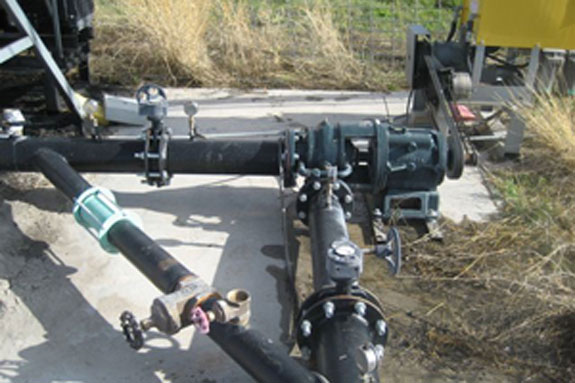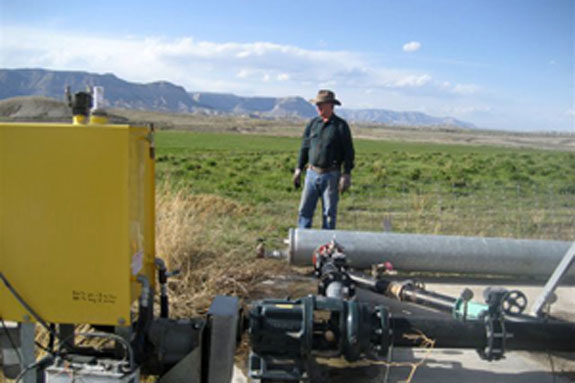Diesel fuel is a large expense in operating a center pivot. The Bartons needed to reduce fuel costs and still follow their irrigation schedule.
The Barton's hay fields are located a half mile from the nearest overhead power line. After considering the cost to have single-phase power run to the field, the Barton's selected a T-L diesel-powered hydraulic center-pivot irrigation system and had it installed in 1998.
This T-L hydraulic center pivot is powered by a diesel motor and uses gravity flow to pressurize the irrigation system. A small DC alternator operates the control panel.
At the time the irrigation system was installed, the national average cost for diesel hovered at around $1 a gallon. In 2008, the Bartons paid $4.25 a gallon. Fuel costs for the irrigation system were about $4,000 a year and rising.
The Bartons met with Ken Gardner, a civil engineer and hydropower specialist with Gardner Engineering, to consider alternative energy options to power their system. They determined that the irrigation system required only about 53 percent of the available water pressure.
The additional pressure could be used to power the turbine. The Bartons could keep their existing irrigation system and reduce their fuel costs to zero.
Siting and layout considerations
The combination of a hydraulic center pivot and hydro turbine are generally a good match when available pressure exceeds the requirements of the irrigation system by 40 pounds per square inch (PSI) or more.
The Bartons receive irrigation water by gravity feed from a reservoir several miles away, which provided 80 PSI of operating pressure at the pivot point, 37 PSI more than required to operate 1,220 feet of pivot and the end gun. The T-L hydraulic pivot installed at the Bartons requires 15 horsepower (HP) to operate correctly.

The Bartons hired Redmond Irrigation in Redmond, Utah to design and install the system. A Cornell turbine from Centex Fluid Products was selected. Centex designs and sells custom hydro turbines, made by Cornell Pump Company, that work with a range of heads, flows and pressures.
The basic method of sizing this system included: assessing the flow (the volume of water passing through the pipe), determining the residual (additional) pressure available, calculating any pipe or other head and flow losses and evaluating the technical requirements of the irrigation system. This data was provided to Centex to design the turbine.
The Cornell hydro turbine was coupled with the T-L variable-displacement hydraulic pump using a belt drive. The system is monitored by the T-L control system. A filter was installed before the turbine to remove sand, gravel and other water debris that can damage the turbine impeller.
Auto valves with a trip switch automatically shut down flow to the turbine if there is a problem in the system. An integrated 12-volt alternator provides the DC voltage required by the control panel.
Financial incentives
The cost for design, equipment and installation of this system was $17,000. The Bartons received a $4,000 cost share under the NRCS Conservation Innovation Grant program.
The estimated simple payback on the hydro turbine system is 2.5 to three years. In Utah, NRCS is currently offering a 65 percent cost share for this type of system under the Environmental Quality Incentives Program (EQIP).
"One disadvantage we discovered," said Barton "is that water must be running through the turbine to move the pivot." The T-L hydraulic pivot continuously "walks" as long as the turbine is operating. "If you are crossing ground you do not want to irrigate, you may want to install a backup diesel motor in addition to the hydro system", said Barton.
Re-nozzling of the pivot may also be necessary to compensate for the reduction in pressure throughout the system.
Roger Barton says farmers and ranchers should be in contact with a knowledgeable consultant early on to determine if they have enough pressure to integrate a hydro turbine.
"Once the resource is determined to be sufficient, look at how to reduce the system costs," said Barton. NRCS offers a cost share and the Rural Energy for America Program (REAP) provides grants, through USDA Rural Development.
An integrated hydro turbine with a gravity-flow irrigation system is an excellent opportunity to reduce fuel costs. These systems are simpler than hydro-electric systems.
The consistent flow and pressure of a gravity-flow hydro resource allow the turbine to be designed for the specific resource and require very few adjustments down the road.
System Specifications
• Hydro resource: Gravity flow from reservoir
• Total pressure: 80 PSI
• Additional pressure: 37 PSI
• Head: 162 ft
• Flow: 888 gpm
• Irrigation system: T-L hydrostatic center pivot
• Hydro turbine: Cornell Turbine (5TR5-F16)
• Runner type: Francis
• Pipe: 10 inch steel w/ compression fittings
• Total System Cost: $17,000 (before cost share)
• Incentives: $4,000
• Cost savings estimate: $4,000 annually
• Simple payback estimate: 4 years
For the contact information of Centex Fluid Products, Cornell Pump Company, Gardner Engineering and Redmond Irrigation and Buildings, visit ATTRA's Directory of Energy Alternatives, a nationwide directory of alternative energy installers and consultants. FG
Leif Kindberg
ATTRA Farm Energy Specialist
—Excerpts from National Sustainable Agriculture Information Service - ATTRA
PHOTOS
Top: Roger Barton has eliminated all irrigation fuel costs by integrating a hydro turbine into his existing center pivot.
Bottom: Gate valves on the incoming line and discharge allow flow to be incrementally adjusted if necessary and shut the system off for maintenance. Photos by Roger Barton.










